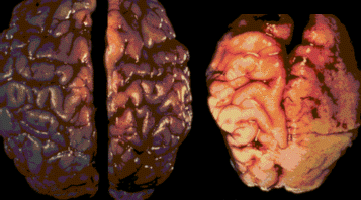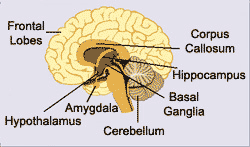Prenatal Alcohol Exposure and the BRAIN
©2000 Teresa Kellerman (updated 2010)
Brain of baby with Brain of baby with heavy
no exposure to alcohol prenatal exposure to alcohol

Photo courtesy of Sterling Clarren, MD |
Alcohol is a teratogen (substance that is toxic to the baby's developing brain). Damage can occur in various
regions of the brain. The areas that might be affected by alcohol exposure depend on which areas are developing at the time the alcohol is consumed. Since the brain and the central nervous system are developing throughout the entire pregnancy, the baby's brain is always vulnerable to damage from alcohol exposure.
The brain is the most sensitive organ to alcohol damage. [Dr. Edward Riley Lecture at San Diego State University, September 25, 2002]
Not all damage from alcohol exposure is seen on brain scans, as lesions are sometimes too small to be detected with current technology, yet large enough to cause significant disabilities.
|
|
Alcohol Exposure During Stages of Pregnancy
1.
During the first trimester, as shown by the research of Drs. Clarren and Streissguth, alcohol interferes with the migration and organization of brain cells. [Journal of Pediatrics, 92(1):64-67]
2.
Heavy drinking during the second trimester, particularly from the 10th to 20th week after conception, seems to cause more clinical features of FAS than at other times during pregnancy, according to a study in England. [Early-Human-Development; 1983 Jul Vol. 8(2) 99-111]
3.
During the third trimester, according to Dr. Claire D. Coles, the hippocampus is greatly affected, which leads to problems with encoding visual and auditory information (reading and math). [Neurotoxicology And Teratology, 13:357-367, 1991]
From the College of Cognitive and Linguistic Sciences at Brown University, Providence, RI.
|
 The regions of the brain that are most seriously affected by prenatal alcohol exposure in terms of ability to function are:
The regions of the brain that are most seriously affected by prenatal alcohol exposure in terms of ability to function are:
Frontal Lobes - this area controls impulses and judgment. The most noteworthy damage to the brain probably occurs in the prefrontal cortex, which controls what are called the Executive Functions.
Corpus Callosum - passes information from the left brain (rules, logic) to the right brain (impulse, feelings) and vice versa. The Corpus Callosum in an individual with FAS/ARND might be smaller than normal, and in some cases it is almost nonexistent. (MRI images)
Hippocampus - plays a fundamental role in memory, learning, and emotion.
Hypothalamus - controls appetite, emotions, temperature, and pain sensation
Cerebellum - controls coordination and movement, behavior and memory.
Basal Ganglia - affects spatial memory and behaviors like perseveration and the inability to switch modes, work toward goals, and predict behavioral outcomes, and the perception of time.
Amygdala – central part of emotional circuitry, senses danger, fear and anxiety; plays major role in recognizing faces and facial expressions, social behavior, aggression, and emotional memory; critical for stimulus-reinforcement association learning.
The hypothalamus, amygdala, and hippocampus are part of the limbic system, which regulates emotions, social and sexual behavior, the “fight or flight” response, and empathy, all areas of concern for individuals with prenatal alcohol exposure.
The term Fetal Alcohol Spectrum Disorders (FASD) includes Fetal Alcohol Syndrome (FAS) and Alcohol Related Neurodevelopmental Disorder (ARND). Individuals with FASD often have symptoms or behavior issues that are a direct result of damage to the prefrontal cortex, which is the part of the brain that controls “executive functions.”
|
Executive Functions
|
Executive functions of
the prefrontal cortex: | Effects of alcohol exposure on behaviors
related to executive functions: |
- inhibition
- problem solving
- sexual urges
- planning
- time perception
- internal ordering
- working memory
- self-monitoring
- verbal self-regulation
- empathy
- regulation of emotion
- motivation
- judgment
|
- socially inappropriate behavior, as if inebriated
- inability to figure out solutions spontaneously
- inability to control sexual impulses, esp. in social situations
- inability to apply consequences from past actions
- difficulty with abstract concepts or time and money
- like files out of order, difficulty processing information
- storing and/or retrieving information
- needs frequent cues, requires policing by others
- needs to talk to self out loud, needs feedback
- diminished sense of remorse, inability to understand others
- moody roller-coaster emotions, exaggerated
- need external motivators to complete menial tasks
- inability to weigh pros and cons when making decisions
|
Children do not need to have full FAS to have significant difficulties due to prenatal exposure to alcohol.
According to research done by Drs. Joanne L. Gusella and P.A. Fried, even light drinking (average one-quarter ounce of absolute alcohol daily) can have adverse affects on the child's verbal language and comprehension skills. [Neurobehavioral Toxicology and Teratology, Vol. 6:13-17, 1984]
Drs. Mattson and Riley in San Diego have conducted research on the neurology of prenatal exposure to alcohol. Their studies show that children of mothers who drank but who do not have a diagnosis of FAS have many of the same neurological abnormalities as children who have been diagnosed with full FAS.
[Neurotoxicology and Teratology, Vol. 16(3):283-289, 1994]
Damage to the brain from alcohol exposure can have an adverse affect on behavior. Alcohol exposure appears to damage some parts of the brain, while leaving other parts unaffected. Some children exposed to alcohol will have neurological problems in just a few brain areas. Other exposed children may have problems in several brain areas. The brain dysfunction is expressed in the form of inappropriate behaviors. Their behavior problems should be viewed with respect to neurological dysfunction. Although psychological factors such as abuse and neglect can exacerbate behavior problems in FAS, we are looking primarily at behavior that is organic in origin. To better understand FASD behavior issues, shift perspective from thinking the child "won't" to "can't."
(Diane Malbin, MSW, Trying Differently Rather Than Harder.)
Sometimes the person's behavior is misinterpreted as willful misconduct (Debra Evensen), but for the most part, maintaining good behavior is outside of the child's control, especially in stressful or stimulating situations. Behavior problems in children with FAS are often blamed on poor parenting skills. While good parenting skills are required, even alcohol exposed children raised in stable, healthy homes can exhibit unruly behavior. The most difficult behaviors are seen in children who were prenatally exposed to alcohol and who also suffer from Reactive Attachment Disorder.
Most children with FASD have some attachment issues, display inappropriate sexual behaviors, show poor judgment, have difficulty controlling their impulses, are emotionally immature, and need frequent reminders of rules. As a result, many will require the protection of close supervision for the rest of their lives.
© 2000-2010 Teresa Kellerman
http://www.fasstar.com
NIAAA Publication on FAS and the Brain
Printable Handout (PDF file = 100k)
Return to FAS Community Resource Center
This web page is http://www.come-over.to/FAS/FASbrain.htm and was last updated March 12, 2010

 The regions of the brain that are most seriously affected by prenatal alcohol exposure in terms of ability to function are:
The regions of the brain that are most seriously affected by prenatal alcohol exposure in terms of ability to function are: